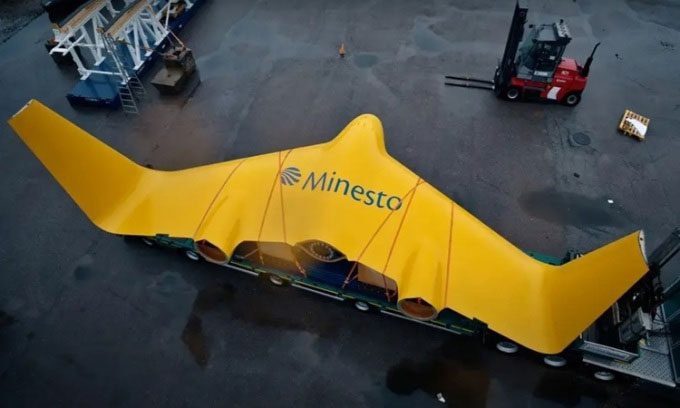Minesto’s Kite System Harnesses Predictable and Abundant Tidal Energy.
The global movement of tidal and ocean currents creates a rich energy supply that can be converted into renewable energy. In pursuit of this goal, the Swedish company Minesto has successfully completed testing of its 1.2 MW Dragon 12 tidal energy kite system. The system will be directly transported to the Faroe Islands in Denmark for installation and commissioning, as reported by Interesting Engineering on November 10.

Design of the tidal energy kite system. (Photo: Minesto).
Founded in 2007, Minesto is a subsidiary of the Swedish aerospace company Saab. Since then, Minesto has successfully developed technology and holds 92 patents in all major markets. According to the company, their kite system technology is a lightweight, flexible solution that can be scaled up to harness tidal energy.
Unlike wind and solar power, tidal and ocean currents are predictable. Tides result from the gravitational pull of the Moon on Earth. The continuous directional movement of seawater caused by gravity, wind, and water density is referred to as ocean currents. Minesto’s solution aims to utilize tidal and ocean currents to generate electricity, employing proprietary and unique technology similar to a kite flying in the wind.
Minesto’s energy system consists of a wing housing a turbine connected directly to a generator in the pod. The system controls the kite’s direction by managing the rudder and lift devices at the rear of the kite. The tether is connected to a simple latch mechanism at the seabed for easy installation and retrieval.
The kite moves by utilizing the hydrodynamic lift generated by its wings, powered by tidal or ocean currents. An automatic controller manages the kite along a pre-defined eight-shaped trajectory, pulling the turbine through water at speeds several times greater than the flow rate.
The turbine shaft drives the generator, transmitting electricity to the grid via cables in the tether. According to Minesto, the kite will move against the main flow. Compared to fixed turbines, the increased speed helps minimize the size of the kite and rotor needed to collect energy. As a result, the installation, operation, and maintenance costs of the system are lower.
This technology enables the Dragon Class kite to generate electricity in locations with weak currents at speeds of 1.2 m/s while saving costs. Minesto claims that their electricity generation system has a weight-to-megawatt ratio that is 15 times lighter than competitors. Additionally, being fully submerged with minimal environmental impact, the system requires only small boats and equipment for installation and maintenance.
Minesto plans to build a tidal kite array with a capacity of 20 – 40 MW at four sites, including Hestfjord, Leirviksfjord, Skopunarfjord, and Svinoyarfjord. According to the company, these arrays will supply 40% of the increasing electricity demand in the Faroe Islands, with a total tidal energy capacity of 120 MW, estimated to generate 350 GWh annually.





















































